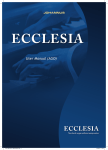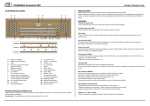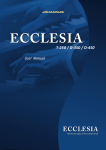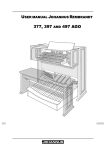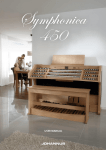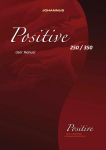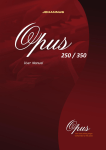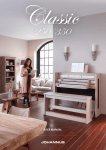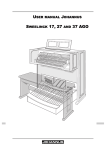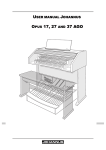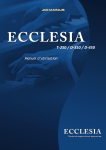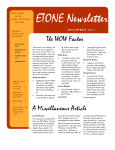Download User Manual Meet the king of instruments
Transcript
JOHANNUS User Manual 770 Meet the king of instruments Manufacturer Johannus Orgelbouw B.V. Address Keplerlaan 2 6716 BS EDE Country The Netherlands Telephone +31 (0)318 63 74 03 Fax +31 (0)318 62 22 38 E-mail [email protected] Website www.johannus.com Version 1.0 Date February 2015 © 2015 Johannus Orgelbouw B.V. All rights reserved. Nothing in this publication may be reproduced, stored in a data file or made public in any form or in any way either electronically, mechanically by way of photocopying, recording or in any other way without the prior written permission of Johannus Orgelbouw B.V. CONTENTS 1 SAFETY........................................................................................... 4 1.1 1.2 1.3 1.4 2 Safety instructions ...................................................................................... 4 Symbols on the organ ................................................................................. 4 Symbols in this manual ............................................................................... 4 Transport and storage ................................................................................ 4 INSTALLATION ............................................................................... 5 2.1 2.2 3 Installation and connection ........................................................................ 5 Switch on .................................................................................................... 6 DESCRIPTION OF THE ORGAN ......................................................... 7 3.1 3.2 3.3 4 Overview of controls................................................................................... 7 Connect and switch on the peripherals ...................................................... 8 External connections .................................................................................. 8 OPERATION ................................................................................... 9 4.1 4.2 4.3 4.4 4.5 4.6 4.7 4.8 General volume .......................................................................................... 9 Expression pedals ....................................................................................... 9 Cathedral .................................................................................................... 9 Intonations.................................................................................................. 9 Stops ........................................................................................................... 9 Couplers .................................................................................................... 10 Accessories ............................................................................................... 11 Capture memory ....................................................................................... 13 4.8.1 4.8.2 4.8.3 Pre-programmed memory locations .......................................................... 13 Capture memory locations ......................................................................... 13 Memory lock .............................................................................................. 14 4.9 Crescendo pedal ....................................................................................... 14 4.10 Quick Access ............................................................................................. 14 4.10.1 4.10.2 5 Programming mode crescendo pedal ........................................................ 14 Orchestral settings ..................................................................................... 14 JOHANNUS MENU .........................................................................15 5.1 5.2 5.3 5.4 5.5 5.6 5.7 5.8 5.9 5.10 5.11 5.12 5.13 Classic Sound Module ............................................................................... 15 Crescendo ................................................................................................. 15 Datadump ................................................................................................. 16 Demo Songs .............................................................................................. 16 General Volume ........................................................................................ 17 Keyboard Config ....................................................................................... 17 Key Volumes ............................................................................................. 17 MIDI Config ............................................................................................... 19 Orchestrals ................................................................................................ 20 Pipe Stops ................................................................................................. 20 Reset Procedures ...................................................................................... 21 Reverb Settings ......................................................................................... 21 Startup Settings ........................................................................................ 22 User Manual American Classic 770 2 5.14 Temperaments.......................................................................................... 23 5.15 Tuning ....................................................................................................... 24 5.16 Version ...................................................................................................... 24 6 ORCHESTRALS ...............................................................................25 6.1 7 Classic Sound Module ............................................................................... 25 MAINTENANCE, TROUBLESHOOTING AND WARRANTY..................26 7.1 Maintenance ............................................................................................. 26 7.1.1 7.1.2 7.2 7.3 8 Maintenance of the cabinet ....................................................................... 26 Maintenance of the manuals ..................................................................... 26 Problems ................................................................................................... 26 Warranty ................................................................................................... 26 MIDI IMPLEMENTATIONS ..............................................................27 8.1 8.2 MIDI Implementation Chart...................................................................... 27 MIDI Specifications ................................................................................... 28 User Manual American Classic 770 3 1 SAFETY 1.1 Safety instructions 1.2 Position the organ on a stable, horizontal surface. Connect the organ to a grounded power socket. Turn off the organ when it is not in use. Do not place the organ in a damp area. Do not expose the organ to liquids. Follow the instructions and precautionary measures in this user manual. Keep this user manual with the organ. The organ may only be opened by a technician authorized by Johannus Orgelbouw B.V. The organ contains static-sensitive components. The warranty is void if the organ is opened by a non-authorized person. Symbols on the organ Warning Warning for electric shock Warning for static-sensitive components 1.3 Symbols in this manual Warning or important information Note 1.4 Transport and storage Pay attention to the following during transport and storage: 1. Remove the music desk and the pedal board from the organ. 2. Relative humidity within the storage area: 40 to 60%. User Manual American Classic 770 4 2 INSTALLATION 2.1 Installation and connection Shown model: American Classic 770 Installing loudspeakers: The external loudspeakers have to be installed by an authorized Johannus installer. Installing console: 1. Position the organ on a stable, horizontal surface. 2. Lean the organ slightly backward. 3. Slide the pedal board (E) against the organ. 4. Set the organ upright. 5. Put the music desk (A) in the appropriate slots (B). These slots are in the outside of the cabinets with draw stops. 6. Place the organ bench (D) over het pedal board. 7. Make sure the voltage of the organ matches the voltage of the main. See the serial plate (C). 8. Connect the organ to a grounded power socket. User Manual American Classic 770 5 2.2 Switch on Switch on the organ with the key switch at the right, next to the manuals. Wait several seconds. Starting the control functions and settings will take some time. The lights of the as standard set functions lit up. The settings appear on the display. User Manual American Classic 770 6 3 DESCRIPTION OF THE ORGAN 3.1 Overview of controls A Pedal stops U CAN: Cancel piston B Swell stops V Manual Choir C Solo stops W Manual Great D Accessories X Manual Swell E Display Y Memory lock F Orchestrals Z Key switch G Antiphonals AA KT: Keyboard Transfer H Ethereal stops AB Capture memory locations General I Great stops AC Capture memory locations Great J Choir stops AD TRANS. : Transposer K Volume control Organ AE MENU L Volume control Cathedral AF - and + pistons M SET / ENTER AG REC: Recall N Capture memory locations Pedal AH Intonation styles O SEQ: Sequence piston AI Intonation variations P Couplers AJ Capture memory locations Swell Q Capture memory locations Choir AK Pre-programmed memory locations R CR: Crescendo (A&B) AL RO: Reeds Off S ZIMB.: Zimbelstern AM Capture memory locations Solo T P.O.: Pipes On/ A.O.: Ancillary On User Manual American Classic 770 7 3.2 Connect and switch on the peripherals You can connect peripherals (for example, a MIDI device) to the organ. Follow the instructions provided in the documentation for the peripheral. 1. 2. 3. 4. 3.3 Switch off the organ and the peripheral. Connect the peripheral to the organ. Switch on the peripheral. Switch on the organ. External connections The MIDI external connections are under the console: MIDI IN: An input for receiving MIDI codes from other devices. MIDI MOD: A programmable MIDI output for connecting a sound module or expander, for example. MIDI SEQ: A non-programmable MIDI output for connecting a Johannus MIDI Sequencer+ or PC with the optional Johannus INTONAT program, for example. The following two external connections are placed in the remote cabinet: AUX IN: A stereo audio input for playing the sound of an external device through the amplifiers of the organ. For example, an expander connected to the organ through the MIDI MOD can be played through the instrument's loudspeakers. AUX OUT: A stereo audio output for connecting an external device (amplifier or recording device, for example). User Manual American Classic 770 8 4 OPERATION 4.1 General volume The general volume of the organ can be adjusted with use of the Johannus Menu. See § 5.4 General Volume. 4.2 Expression pedals The organ has five expression pedals. One is configured as a crescendo pedal, the others are configured as swell pedals for the existing divisions. The Pedal division is combined with the Great division. Using an expression pedal which is set as a swell pedal will next to the volume also changes the timbre of the stops. By this the effect of the swell box shutters of a pipe organ is simulated. 4.3 Cathedral The organ is equipped with the Adaptive Surround Reverb ASR-12 system. This effect provides a spatial reproduction of the organ sound. With use of the Johannus Menu the following settings are adjustable per intonation style: Reverb Program and 3D Surround effect. See § 5.12 Reverb Settings. 4.4 Organ: The volume of the organ can be adjusted with the ORGAN volume control. Cathedral: The reverb volume can be adjusted smoothly with the CATHEDRAL volume control. Intonations The organ has 12 intonations, divided in three styles: Romantic (ROM), Symphonic (SYM) and Baroque (BAR) and four variations per style: A, B, C and D. Select an intonation style by pressing the ROM, SYM or BAR piston. Select an intonation variation by pressing the A, B, C or D piston. 4.5 Stops The stops are activated via stop draw knobs, pre-programmed memory locations or capture memory locations. The lamp of the draw knob lights up when the associated stop is active. The stops are divided into the following groups: Pedal: Activates the stops associated with the Pedal. Choir: Activates the stops associated with the Choir. Great: Activates the stops associated with the Great. Swell: Activates the stops associated with the Swell. Solo: Activates the stops associated with the Solo. Ethereal: Activates the stops associated with the Ethereal. User Manual American Classic 770 9 Solo- and orchestral voices The organ is equipped with seven solo- and orchestral voices: Clarinet Oboe Viola Bach Trumpet Trumpet Trombone Tuba These solo- and orchestral voices are activated by the stop switches on the right of the display. The lamp in the stop switch lights up when the associated voice is active. See chapter 6 ORCHESTRALS for more information on solo- and orchestral voices. Solo- and orchestral voices are standardly playable from a factory defined manual. This can be changed via Quick Access, see § 4.10.2 Orchestral settings, and via the Johannus Menu, see § 5.9 Orchestrals. 4.6 Couplers Manual couplers: SWELL - GREAT: Fully couples all keys of the Swell to the Great. CHOIR – GREAT: Fully couples all keys of the Choir to the Great. SOLO/ETH. – GREAT: Fully couples all keys of the Solo and Ethereal to the Great. SWELL - CHOIR: Fully couples all keys of the Swell to the Choir. SOLO/ETH. - CHOIR: Fully couples all keys of the Solo and Ethereal to the Choir. SOLO/ETH. - SWELL: Fully couples all keys of the Solo and Ethereal to the Swell. Pedal couplers: GREAT - PEDAL: Fully couples all keys of the Great to the Pedal. SWELL - PEDAL: Fully couples all keys of the Swell to the Pedal. CHOIR - PEDAL: Fully couples all keys of the Choir to the Pedal. SOLO/ETH. - PEDAL: Fully couples all keys of the Solo and Ethereal to the Pedal. User Manual American Classic 770 10 4.7 Accessories Antiphonals On an instrument with separate divisions (each division having its loudspeakers) one or more divisions may be connected to a second speaker set. The division concerned can be switched from the main speaker set to e.g. a speakerset behind the choir, by means of the switch Choir Antiphonal or Solo/Eth. Antiphonal. CAN: Cancel Cancel is a function to switch off all stops at once. Cantus Firmus (melody coupler) Cantus firmus: Latin for ‘fixed voice’ or in organs ‘solo voice’ or ‘melody coupler’. Couples the Swell monophonic to the Great. Only the highest key that is played on the Great is coupled from the Swell to the Great. With use of a solo registration on the Swell in this way a solo is heard while playing only on the Great. If only the highest key of a chord is released, the key activated by melody coupler is dropped until a new highest key is played. Use the stop switches to activate the melody coupler on swell or melody coupler on choir by It is advisable not to use the Cantus Firmus in combination with the coupler SWELL - GREAT because this overrules the solo function of the Cantus Firmus. CH: Chorus Chorus is a function for lightly detuning the organ stops to give it a broader and livelier sound. Fix Accessories When the couplers and the tremulants are used in the fixed (preset) combinations or free (capture) combinations or when the 0-piston or CAN piston is used, the couplers and tremulants will change with it. This can be prevented by pressing the Fix Accessories stop switch. As long as this tab is switched on, the couplers and tremulants can only be switched on or off manually KT: Keyboard Transfer Keyboard Transfer is a function to switch the manuals of the Choir and the Great. When Keyboard Transfer is active manual 1 is the Great manual and manual 2 is the Choir manual. Keyboard Transfer also switches the divisional pistons of the relevant manuals. MB: Manual Bass (bass coupler) Couples the Pedal monophonic to the Great. Only the lowest key that is played on the Great is coupled from the Pedal to the Great. If only the lowest key of a chord is released, the pedal key activated by the Manual Bass function is dropped until a new lowest key is played. Activate the Manual Bass with the MB piston. It is advisable not to use the Manual Bass while playing the pedal board to avoid double bass tones. User Manual American Classic 770 11 P.O./ A.O.: Pipes On/Ancillary Off If the instrument consists of a combination of a number of pipe organ voices and a number of electronically generated voices (a so-called hybrid instrument) the piston A.O. (Ancillary Off) may occur on the instrument mostly in combination with the piston P.O. (Pipes On). Pressing the P.O. piston activates the pipe organ part of the combined instrument. Only after pressing the Pipes On piston can the voices of the pipe organ part be switched on or off with the appropriate stops Pressing the Ancillary Off piston switches off the electronic voices of the hybrid organ all at once. REC: Recall Recall is a function to cancel the last change of registration. RO: Reeds Off Reeds Off is a function to switch off all reed stops simultaneously. As long as this piston is pressed, no reed stops can be activated. When this function is switched off, the reed stops that were on are activated again. Activate the Reeds Off with the RO piston. SEQ: Sequence On/Off Sequence is a function for sequential selecting general capture memory locations. 1. Select a general capture memory location to start (for example level 2, location 2). 2. Pressing a random piston of the memory locations of the Pedal selects the previous general memory location, pressing a random piston of the general memory locations selects the next general memory location. S/S: All Swells to Swell All Swells to Swell transforms the swell pedal of the Swell into a swell pedal of the entire organ. The other swell pedals will be switch off then. If no expression pedal is set as swell pedal of the Swell, the S/S stop switch cannot be activated. TRANS.: Transposer The Transposer function shifts the pitch by half-tone increments (from -8 to +8). The transposer setting can be read on the display (Trans: …). 1. 2. 3. Press the TRANS. piston. Use the - and + pistons to set the pitch. When the transposer change needs to be saved, press the SET piston in the time the TRANS. piston is lit. ZIMB.: Zimbelstern The American Classic 770 has been prepared for the connection of an external Zimbelstern with an operating voltage of 12 Volt. This can be activated by the ZIMB. piston. User Manual American Classic 770 12 4.8 Capture memory 4.8.1 Pre-programmed memory locations Pre-programmed memory locations are available by operating pistons T1 and T2. These two memory locations have factory settings appropriate for the loud Tutti. Calling up a pre-programmed memory location: Press a pre-programmed memory location (T1 or T2). The active stops light up. Programming a pre-programmed memory location: The current setting of the pre-programmed memory location will be lost. Although it is possible to store any registration under a piston of a preprogrammed memory location it is advisable to select a registration matching the text of the piston. 1. 2. 3. 4. Select the desired stops. Press the SET piston. Hold the piston. Press the desired pre-programmed memory location (T1 or T2). Release the SET piston. 4.8.2 Capture memory locations Through use of the capture memory, a registration can be activated with just one piston. The capture memory consists of 250 levels. These levels can be seen on the display (Mem:…). The American Classic 770 has eight general memory locations (general pistons 1-8) and six separate memory locations per divisional (divisional pistons 1-6) per level. Programming a capture memory location: The current setting of the capture memory location will be lost. 1. 2. 3. 4. 5. Select the desired stops. Use the - and + pistons to select a level (1-250) on the display. Press the SET piston. Hold in the piston. Press the desired memory location. Release the SET piston. Calling up a capture memory location: 1. Use the - and + pistons to select the desired level (1-250) on the display. 2. Press the desired memory location. The active stops light up. User Manual American Classic 770 13 4.8.3 Memory lock The memory can be secured through a key switch. By turning the key a quarter to the right, the security of the memory is removed. In this position, the key cannot be taken out of the lock. Turn the key a quarter to the left to avoid unwanted overwriting of the memory. Optionally the key can be taken out of the lock. The actual state of the memory lock is also reflected in the SET piston. This piston will light up when the key of the memory lock is turned to the right, indicating that the SET piston can be used. If the SET piston is not lighted, no menu functions for which the SET piston needs to be pressed can be used. 4.9 Crescendo pedal The crescendo pedal can be used to activate 20 registrations step-by-step. These registrations start with very quiet (pianissimo) to very loud (tutti). The default registrations of the 20 steps can be changed. See § 5.2 Crescendo. Activating the crescendo pedal If the crescendo pedal is not activated it is indicated on the displays with Cresc:Off. Use the CRA or CRB piston to activate the crescendo pedal. The display indicates the current step. 4.10 Quick Access Quick Access is a function to quickly access a certain function of the organ. 4.10.1 Programming mode crescendo pedal This function is not available if no expression pedal is set as crescendo pedal. Pressing the SET and CRA or CRB piston simultaneously enters the programming mode of the crescendo pedal. See § 5.2 Crescendo, sub 4 for next steps. 4.10.2 Orchestral settings Through use of Quick Access it is possible to access the settings of a solo- or orchestral voice. An alternative voice can be selected and the voice can be assigned directly to a manual or the pedal. Press the SET piston simultaneously with a piston of a solo- or orchestral voice. The current choice of the voice and the manual assignment appears on the display. See § 5.9 Orchestrals for further steps. User Manual American Classic 770 14 5 JOHANNUS MENU In the Johannus Menu several functions of the organ can be set: Press the MENU piston to activate the Johannus Menu on the display. Navigating the menu is done with the - and + pistons. Confirmation of a choice is done with the SET piston. Cancel or step back in the menu is done with the MENU piston. The Johannus Menu consists of the following functions: 5.1 Function More information Classic Sound Module Crescendo Datadump Demo Songs General Volume Keyboard Config Key Volumes MIDI Config Orchestrals Pipe Stops Reset Procedures Reverb Settings Startup Settings Temperaments Tuning Version §5.1 §5.2 §5.3 § 5.4 § 5.5 § 5.6 § 5.7 § 5.8 § 5.9 § 5.10 § 5.11 § 5.12 § 5.13 § 5.14 § 5.15 § 5.16 Classic Sound Module Please refer to the separate ‘Classic Sound Module’- manual for more elaborate information on the Classic Sound Module. See §6.1 Classic Sound Module for an overview of the available instruments. 5.2 Crescendo The crescendo pedal contains 20 pre-programmed registrations. These registrations start with very quiet (pianissimo) to very loud (tutti). These pre-programmed registrations can be changed. Step 0 of the crescendo pedal cannot be changed. 1. 2. 3. 4. 5. 6. 7. Press the MENU-piston. Use the - and + pistons to select the Crescendo function on the display. Press the SET piston. The first step of the crescendo pedal appears on the display. Use the - and + pistons to select the step which has to be changed. Change the registration and press the SET piston to save the new registration in the memory of the organ. Repeat steps 5 and 4 if more crescendo pedal steps has to be changed. Press the MENU piston 2x to exit the Johannus Menu. User Manual American Classic 770 15 5.3 Datadump The Datadump function sends several settings from the organ to a storage medium (the Johannus MIDI Sequencer+, for example) through the MIDI SEQ output. See § 3.3 External connections. The settings to send are: the content of all capture memory locations and all settings which can be set via the Johannus Menu, except Key Volumes. Key Volume settings are a part of the intonation data. These data can be received with the optional Johannus INTONAT software. a. Sending data from the organ 1. Press the MENU-piston. 2. Use the - and + pistons to select the Datadump function on the display. 3. Press the SET piston. The Press SET to send data text appears on the display. 4. Make sure the desired storage medium, the Johannus MIDI Sequencer+ for example, is properly connected. 5. Press the SET piston. When data is being sent, Sending data appears on the display. Sending data will take some time. Do not use the organ when the Sending data text is on the display. 6. 7. If the data dump is complete, the main menu appears on the display. Press the MENU piston to exit the Johannus Menu. b. Uploading data to the organ Receiving a data file has no relation to the Johannus Menu and can be done on every moment the organ is switched on, except when playing a Demo Song. Make sure to upload only data files which are recorded from the instrument concerned. Uploading a data file from another instrument may jeopardize the functioning of your instrument. 1. 2. 3. 5.4 Make sure the storage medium, the Johannus MIDI Sequencer+ for example, with a previous recorded data file is properly connected. Start sending the data file on the sequencer. A message that a data file is being received appears on the display of the organ. When the upload is completed the main screen of the display appears automatically. Demo Songs The Demo Songs function plays several demo songs. 1. 2. 3. 4. 5. Press the MENU piston. Use the - and + pistons to select the Demo Songs function on the display. Press the SET piston. The titles of the demo songs appear on the display. Use the - and + pistons to select one of the demo songs. Press the SET piston to select the demo song. User Manual American Classic 770 16 6. 7. 8. 5.5 Use the - and + pistons to choose whether to play only the selected demo song (play one demo) or all demo songs (play all demo’s). Press the SET piston to start playing the selected demo song(s). The title and composer of the demo song appears on the display. Press the MENU piston 2x after having played the demo song(s) to exit the Johannus Menu. General Volume The General Volume function sets the general volume of the organ. 1. 2. 3. 4. 5. 6. 5.6 Press the MENU piston. Use the - and + pistons to select the General Volume function on the display. Press the SET piston. The actual setting appears on the display. Use the - and + pistons to select the desired volume. Press the SET piston to program the selected volume into memory and to return to the Johannus Menu. Press the MENU piston exit the Johannus Menu. Keyboard Config The Keyboard Config function sets the operation of the keys. 1. 2. 3. 4. 5. 6. 7. 8. 5.7 Press the MENU piston. Use the - and + pistons to select the Keyboard Config function on the display. Press the SET piston. The available manuals appear on the display. Use the - and + pistons to select the manual the setting of which must be changed. Press the SET piston. The available options appear on the display. Use the - and + pistons to select a setting for the operation of the keys. - Automatic: The manual has been set to High. When activating a programmable MIDI stop or optional solo- or orchestral voice, the manual will be set to Velocity automatically. - High: The keys respond when touched very lightly. - Low: The keys respond when pressed further. - Velocity: The keys are touch-sensitive. Press the SET piston to program the settings. The available manuals appear on the display again. Repeat steps 4 to 7 to change the setting of another manual or press the MENU piston 2x to exit the Johannus Menu. Key Volumes The Key Volumes function makes it possible to adjust the key volumes of each stop. The Key Volumes function consists of the following sub functions: a. Adjust b. Reset one stop c. Reset ALL stops User Manual American Classic 770 17 a. Adjust The Adjust function sets the volume per key, stop and intonation style. Key volumes of the optional solo- and orchestral voices cannot be adjusted. 1. 2. 3. 4. 5. Switch off all stops. Select an intonation style or variation. Press the MENU piston. Use the - and + pistons to select the Key Volumes function on the display. Press the SET piston. The sub functions of the Key Volumes menu appears on the display. If you are asked to enter a code, the Key Enter code: Volumes function has been secured at the _ _ _ _ request of the owner. Contact the owner or dealer to retrieve the code. Enter the code using the pistons of the capture memory locations and press the SET piston. 6. 7. 8. 9. 10. 11. 12. 13. 14. 15. 16. 17. Use the - and + pistons to select the sub function Adjust and press the SET piston. A question to select a stop to adjust appears on the display. Activate one stop. A question to press a key appears on the display. Press one key on the corresponding division and hold the key. The display will now show following Key: the key indicator and following Vol: the volume. Use the - and + pistons to set the desired volume. Press the SET piston to save the change. The display requests confirmation. Use the - and + pistons to select No or Yes. Press the SET piston to confirm. Press the MENU piston to return to the Key Volume menu. If the changes have not been saved, the display will show Discard changes?. Use the - and + pistons to select Yes for discarding and press the SET piston. Go to step 17. Use the - and + pistons to select No if the changes still has to be saved and press the SET piston. Press the SET piston. The display requests confirmation. Use the - and + pistons to select Yes. Press the SET piston for confirmation. Press the MENU piston 3x to exit the Johannus Menu. More key volumes can be changed by pressing another key or by selecting another stop. b. Reset one stop The Reset one stop sub function resets the key volumes for one stop in one intonation or variation to the factory setting. 1. Switch off all stops. 2. Select an intonation style or variation. 3. Press the MENU piston. 4. Use the - and + pistons to select the Key Volumes function on the display. 5. Press the SET piston. The sub functions of the Key Volumes menu appear on the display. User Manual American Classic 770 18 If you are asked to enter a code, the Key Enter code: Volumes function has been secured at the _ _ _ _ request of the owner. Contact the owner or dealer to retrieve the code. Enter the code using the pistons of the capture memory locations and press the SET piston. Use the - and + pistons to select the Reset one stop sub function on the display. 7. Press the SET piston. A question to select a stop to reset appears on the display. 8. Activate one stop. A question to confirm appears on the display. 9. Use the - and + pistons to select No or Yes. 10. Press the SET piston to confirm and to return to the Key Volumes menu. 11. Press the MENU pistons 2x to exit the Johannus Menu. 6. c. Reset ALL stops The Reset ALL stops function resets the key volumes of all stops in one intonation style or variation to the factory setting. 1. Select an intonation style or variation. 2. Press the MENU piston. 3. Use the - and + pistons to select the Key Volumes function on the display. 4. Press the SET piston. The sub functions of the Key Volumes menu appear on the display. If you are asked to enter a code, the Key Enter code: Volumes function has been secured at the _ _ _ _ request of the owner. Contact the owner or dealer to retrieve the code. Enter the code using the pistons of the capture memory locations and press the SET piston. 5. 6. 7. 8. 9. 5.8 Use the - and + pistons to select the Reset ALL stops sub function on the display. Press the SET piston. A question to confirm appears on the display. Use the - and + pistons to select No or Yes. Press the SET piston to confirm and to return to the Key Volumes menu. Press the MENU piston 2x to exit the Johannus Menu. MIDI Config MIDI is a protocol for communication between the organ and other devices, such as PC, Johannus MIDI Sequencer+ or other musical instruments. The programmable MIDI stops allow you to control any module voice through any MIDI channel (1-16). The four parts of the programmable MIDI code are: Channel, Msb, Lsb en Voice. 1. 2. Press the MENU piston. Use the - and + pistons to select the MIDI Config function on the display. User Manual American Classic 770 19 3. 4. 5. 6. 7. 8. 9. 10. 11. 12. 13. 5.9 Press the SET function. A question to select a MIDI stop to configure appears on the display. Activate the MIDI stop which has to be configured. The settings of the corresponding MIDI stop appear on the display. An pointer is located in front of the value of the MIDI channel. Use the - and + pistons to select the desired MIDI channel. Press the SET piston. The pointer jumps to the MSB value. Use the - and + pistons to select the desired MSB value. Press the SET piston. The pointer jumps to the LSB value. Use the - and + pistons to select the desired LSB value. Press the SET piston. The pointer jumps to the Voice value. Use the - and + pistons to select the desired Voice value. Press the SET piston. The selected configuration is now stored in memory. The pointer jumps back to the MIDI channel location. Press the MENU piston 2x to exit the Johannus Menu. Orchestrals The solo- and orchestral voices are standard playable from a factory defined manual. This can be changed via the Johannus Menu. Accessing the settings of a solo- or orchestral voice can also be done with the Quick Access function. See § 4.10.2 Orchestral settings. 1. 2. 3. 4. 5. 6. 7. 8. Press the MENU piston. Use the - and + pistons to select the Orchestrals function on the display. Press the SET piston. The solo- and orchestral voices appear on the display. Use the - and + pistons to select the solo- or orchestral voice from which the settings has to be changed. Press the SET piston. The actual settings of the solo- or orchestral voice appear on the display. Use the - and + pistons to select the desired voice. Press a key on the manual or pedal on which the solo- or orchestral voice has to be assigned. The new assignment appears on the display. Press the MENU piston 3x to exit the Johannus Menu. 5.10 Pipe Stops Please contact your Johannus dealer, should you desire to change the settings of the Pipe Stops. User Manual American Classic 770 20 5.11 Reset Procedures The Reset Procedures function can be used to reset a number of settings to the factory settings. 1. 2. 3. 4. 5. 6. 7. Press the MENU piston. Use the - and + pistons to select the Reset Procedures function on the display. Press the SET piston. The available Reset Procedures appear on the display. Use the - and + pistons to select the desired reset procedure: - Crescendo def.: Resets the factory settings of the 20 steps of the crescendo pedal. - Cust. Temperament def.: Resets the custom programmable temperament to equal temperament. - Memory default: Clears the entire capture memory. - MIDI default: Resets the factory settings of the MIDI stops. - Preset default: Resets the factory settings of the preprogrammed memory locations. - Reverb default: Resets the factory settings of the reverb. - Orchestrals default: Resets the factory setting of the solo- and orchestral voices. Press the SET piston. A question to confirm appears on the display. Use the - and + pistons to select No or Yes. Press the SET piston to confirm and to return to the Reset Procedures menu. Press the MENU piston 2x to exit the Johannus Menu. 5.12 Reverb Settings The organ is equipped with the Adaptive Surround Reverb ASR-12 system. With this system it is possible to choose a matching reverb for each intonation style. The 3D Surround effect can be enabled. 1. 2. 3. 4. 5. 6. 7. 8. 9. Use the intonation style pistons to activate an intonation style the reverberation of which has to be changed. Press the MENU piston. Use the - and + pistons to select the Reverb Settings function on the display. Press the SET piston. A list of available sub functions appears on the display. Use the - and + pistons to select the desired sub function. Press the SET piston. The actual setting of the sub function appears on the display. Use the - and + pistons to select the desired setting. Press the SET piston to program the setting into memory and to return to the Reverb Settings menu. If necessary repeat steps 5 to 8 for another sub function or press the MENU piston 2x to exit the Johannus Menu. User Manual American Classic 770 21 5.13 Startup Settings The Startup Settings can be used to select the startup defaults for the following functions: a. Chorus On/Off b. Default Intonation a. Chorus On/Off Startup Setting Chorus On/Off determines whether the Chorus function is switched on at startup of the organ. 1. 2. 3. 4. 5. 6. 7. 8. Press the MENU piston. Use the - and + pistons to select the Startup Settings function on the display. Press the SET piston. A list with available startup settings appears on the display. Use the - and + pistons to select the Chorus On/Off setting. Press the SET piston. The actual setting appears on the display. The default setting is On. Use the - and + pistons to select the desired setting. Press the SET piston to confirm and to return to the Startup Settings menu. Press the MENU piston 2x to exit the Johannus Menu. b. Default Intonation Startup Setting Default Intonation determines which intonation style is selected at startup of the organ. 1. Press the MENU piston. 2. Use the - and + pistons to select the Startup Settings function on the display. 3. Press the SET piston. A list with available startup settings appears on the display. 4. Use the - and + pistons to select the Default Intonation function. 5. Press the SET piston. The actual setting appears on the display. 6. Use the - and + pistons to select the desired intonation style. 7. Press the SET piston to confirm and to return to the Startup Settings menu. 8. Press the MENU piston 2x to exit the Johannus Menu. User Manual American Classic 770 22 5.14 Temperaments The Temperaments function sets the temperament. The set temperament can be read on the display behind the Temp: text. There are eleven different temperaments: Equal (normal temperament) Young II Vallotti Kirnberger III Kirnberger II Neidhardt III Werckmeister III 1/6 Meantone (1/6 comma meantone) 1/5 Meantone (1/5 comma meantone) 1/4 Meantone (1/4 comma meantone) Pythagorean Besides these eleven temperaments it is possible to configure a custom temperament: Custom (free programmable temperament) Selecting a temperament 1. Press the MENU piston. 2. Use the - and + pistons to select the Temperaments function on the display. 3. Press the SET piston. A list of available temperaments appears on the display. The pointer indicates the actual temperament. 4. Use the - and + pistons to select the desired temperament. 5. Press the MENU piston 2x to exit the Johannus Menu. Programming a custom temperament With this function it is possible to create a personal temperament. Every key can be detuned with increments of 1 cent. The minimum value is -50 cents; the maximum value is 50 cents. The programming can be done using the middle octave of the Great and is automatically calculated for all keys of the organ. 1. 2. 3. 4. 5. 6. 7. 8. 9. Press the MENU piston. Use the - and + pistons to select the Temperaments function on the display. Press the SET piston. A list of available temperaments appears on the display. The pointer indicates the actual temperament. Use the - and + pistons to select the Custom Programming function. Press the SET piston. Press and hold a key of the middle octave of the Great. The detune setting of the pressed key appears on the display. The given detuning is compared to the equal temperament. Use the - and + pistons to select the desired pitch of the pressed key. If necessary repeat steps 6 and 7 for another key of the middle octave. Press the MENU piston 2x to exit the Johannus Menu. Using the reset procedure Cust. Temperament def. the Custom Temperament can be reset to equal temperament. See § 5.11 Reset Procedures. User Manual American Classic 770 23 5.15 Tuning The Tuning function shifts the pitch in steps of 1 Hz from 426 Hz to 454 Hz (standard pitch is a = 440 Hz). 1. 2. 3. 4. 5. 6. Press the MENU piston. Use the - and + pistons to select the Tuning function on the display. Press the SET piston. The actual Tuning setting appears on the display. Use the - and + pistons to select the desired pitch. Press the SET piston to program the new setting and to return to the Johannus Menu. Press the MENU piston to exit the Johannus Menu. 5.16 Version The Version function shows the version number of the software of the organ. 1. 2. 3. 4. Press the MENU piston. Use the - and + pistons to select the Version function on the display. Press the SET piston. The data of the software of the organ appears on the display. Press the MENU piston 2x to exit the Johannus Menu. User Manual American Classic 770 24 6 ORCHESTRALS The American Classic 770 is standardly equipped with the following seven solo orchestral voices, that can be activated by the stop switches on the right of the display: Clarinet Oboe Viola Bach Trumpet Trumpet Trombone Tuba Solo- and orchestral voices are standard playable from a factory defined manual. This can be changed by the user via Quick Access, see §4.10.2 Orchestral Settings, and via the Johannus Menu, see § 5.9 Orchestrals. 6.1 Classic Sound Module Besides the seven solo orchestral voices, the American Classic is equipped with the Classic Sound Module, which provides you another 40 extra instruments. Instrument name Flute Piccolo Recorder Panflute Horn English Horn Cello Violin Orchestral strings Warm strings Bright strings Bell strings Harp Harpsichord Timpani Chimes Celesta 1 Celesta 2 Woodharp Handbells Instrument type Orchestral instrument Orchestral instrument Orchestral instrument Orchestral instrument Orchestral instrument Orchestral instrument Orchestral instrument Orchestral instrument Electronic instrument Electronic instrument Electronic instrument Electronic instrument Orchestral instrument Keyboard instrument Orchestral instrument Percussion instrument Keyboard instrument Keyboard instrument Orchestral instrument Orchestral instrument User Manual American Classic 770 Instrument name Chrysoglott Carillon Choir 1 Choir 2 Harmonic Flute 8’ Flute Celeste 8’ Viola Celeste 8’ English Horn 8’ Clarinet 8’ Ranket 8’ Tuba 8’ Chamade 8’ Terzian II Sesquialtera II Cantus Firmus II-IV Reed Organ Gospel Organ 1 Gospel Organ 2 Tibia Organ Tracker Action Instrument type Percussion instrument Percussion instrument Special effect Special effect Organ stop Organ stop Organ stop Organ stop Organ stop Organ stop Organ stop Organ stop Organ stop Organ stop Organ stop Keyboard instrument Electronic instrument Electronic instrument Electronic instrument Special effect (organ noise) 25 7 MAINTENANCE, TROUBLESHOOTING AND WARRANTY 7.1 Maintenance Overview Component Cabinet Manuals 7.1.1 Maintenance Cleaning. See § 7.1.1 Cleaning and removing scratches. See § 7.1.2 Frequency As required As required Maintenance of the cabinet Do not use furniture polish or teak oil to clean the organ cabinet. Direct sunlight may discolor the organ cabinet. 1. 2. Clean the cabinet with a damp cloth. Rub the cabinet dry with a lint-free cloth. 7.1.2 Maintenance of the manuals The manuals are plastic. Do not use aggressive cleaning agents such as paint thinner or acetone to remove dirt. 1. 2. 3. 7.2 Clean the manuals with a damp cloth. Rub the manuals dry with a lint-free cloth. Remove any scratches with car polish. Problems Overview Symptom Pedal board does not work properly Organ functions do not work properly 7.3 Cause The pedal magnet is making poor contact with the magnetic switch at the rear of the pedal front cover. The organ is not grounded. Solution Reposition the pedal board. Connect the organ to a grounded power socket. Warranty The conditions are specified in the warranty certificate. The warranty is void if changes or repairs are made to the organ by persons or organizations that are not authorized by Johannus Orgelbouw B.V. User Manual American Classic 770 26 8 MIDI IMPLEMENTATIONS 8.1 MIDI Implementation Chart JOHANNUS Organs Date: September 2008 Version 1.00 MIDI Implementation card Functions Transmitted Recognized Remarks See MIDI Specs Basic Channel Default Changes See MIDI Specs See MIDI Specs See MIDI Specs Y1 Mode Default Messages Altered Mode 3 N * * * * * * * * Mode 3 N N True Voice 36 - 96 * * * * * * * * Note Number Note ON Note OFF 9nH v=1 - 127 9nH (v=64) 9nH (v=0) Keys Channels N N Velocity After Touch Pitch Bend Control Change Program Change 9nH v=1 - 127 9nH v=1 - 127 9nH v=0, 8nH v=* Velocity ON Velocity OFF *=irrelevant N 7 11 100/101/6 100/101/6 Y Y Y Y : True# See MIDI Specs * * * * * * * * See MIDI Specs See MIDI Specs See MIDI Specs See MIDI Specs See MIDI Specs See MIDI Specs See MIDI Specs System Exclusive General Volume Expr. pedals Pitch Transposer Common : Song Pos : Song Sel : Tune N N N N N N System Real Time : Clock : Commands N N N N Aux : Reset All Contr. : Local ON/OFF : All Notes OFF : Active Sense : Reset N N Y N N N N Y N N Notes Mode 1: OMNY ON, POLY Mode 3: OMNY OFF, POLY User Manual American Classic 770 1 Depends on number of divisions Mode 2: OMNY ON, MONO Mode 4: OMNY OFF, MONO Y=YES N=NO 27 8.2 MIDI Specifications This paragraph describes the specifications on the MIDI Implementation Chart in more detail. Default basic channels (transmitted/recognized) American Classic 770: 1: Choir 2: Great 3: Swell 4: Pedal 12: Stops Basic channel changes (transmitted) Can be programmed through the MIDI Config. See § 5.8 MIDI Config. Control changes (transmitted) Controller 7 (07h) General volume, with volume values 40 (28h) - 127 (7Fh). Controller 11 (0Bh) Swell pedal, with volume values 55 (37h) - 127 (7Fh). Controller 6 (06h) Pitch, with pitch values (21h) - 95 (5Fh). Pitch value 64 (40h) = a = 440Hz. The following applies to the pitch: LSB 100 (64h) 1 (01h) and the MSB 101 (65h) 0(00h). Transposer, with transposer values 56 (38h) - 72 (48h). Transposer value 64 (40h) = a = 440Hz. The following applies to the transposer: LSB 100 (64h) 2 (02H) and the MSB 101 (65h) 0(00h). Control changes (recognized) Controller 7 (07h) General volume, with volume values 0 (00h) - 127 (7Fh). Volume values less than 40 (28h) are treated as 40 (28h). Controller 11 (0Bh) Swell pedal, with volume values 0 (00h) - 127 (7Fh). Volume values less than 55 (37h) are treated as 55 (37h). Program changes (transmitted/recognized) Organ stops: Depends on the number of stops and the sequence of stops. MIDI stops (programmable): 1-128. See § 5.8 MIDI Config. System exclusive messages (transmitted/recognized) Each ‘sys ex’ (system exclusive) message largely looks the same. The first 7 bytes and the last byte are always the same. Only the value of the 8th byte varies. This is the ‘sys ex message’ that Johannus generally uses: F0 00 4A 4F 48 41 53 XX F7 (hexadecimal). The ‘sys ex messages’ described below only indicates the value of the 8th byte (XX) and the output from which it is transmitted. All stops off The ‘all stops off’ sys ex code is 7F. This sys ex code is transmitted through the MIDI SEQ. output when the cancel piston (CAN) is pressed. When an ‘all stops off’ sys ex code is received, all stops on the instrument are switched off. User Manual American Classic 770 28 Pushbutton values When a piston is pressed, a sys ex code is transmitted with the value of the piston that is pressed (for example PP = 00 P = 01) through the MIDI MOD. output. These sys ex codes are only important when the Johannus sound module CSM 128 is connected to your instrument. Other MIDI codes (transmitted) Press the cancel piston (CAN) to transmit the sys ex code, ‘all stops off’ and all volume settings through the MIDI SEQ. output. User Manual American Classic 770 29 User Manual American Classic 770 30 User Manual American Classic 770 31
































